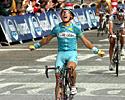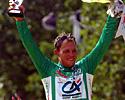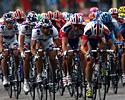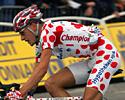
Recently on Cyclingnews.com |
|
|
View from the lab - Ric Stern's Tour de France sports science
British ABCC coach Ric Stern (www.cyclecoach.com) is a regular contributor to Cyclingnews' Form & Fitness section along with being a full time coach. Still an active rider when time allows, Ric will be providing a physiological insight into the challenges that face the riders in the Tour.
What it takes

|
The Tour is now over and I've taken a few days to reflect on what's been an exciting and interesting edition of the 2005 Tour de France. Before I go on to look at some (hopefully) interesting points about the Tour and what it (may) take, I'll briefly mention the last stage, which I haven't as yet commented on (apart from talking to my wife about it!)
Going into the final stage there were two important considerations prior to the Tour finishing. Would Thor Hushovd retain the maillot vert, or would Robbie or Stuart take it from him on the final day. Additionally, who would win the last stage and would the winner affect the outcome of the green jersey competition?
As we know, Alexandre 'I like to attack a lot' Vinokourov won the stage after jumping away with Brad McGee in the final kilometres. Here, Vino sat back a little behind McGee and maybe pretended he didn't have the legs. Then in the final metres went past McGee and won. Brilliantly. For me, it was the best stage of the Tour (and I've never thought that of the final stage before).

|
Thor Hushovd, in finishing seventh on the stage, won the maillot vert competition. Although he didn't take a stage win, he was, by definition, the most consistent daily finisher. Sprinting doesn't just have to be from a large peloton, but can also be done from a small breakaway group. Therefore, even non-sprinters should practice sprinting to try and maximise the chance of a victory (assuming you do bunched racing, as opposed to solo TTs only, which don't require any sprint training). While the tactics and skills of sprinting are too detailed to go into for this article, I'll briefly mention a couple of sprint training sessions to increase your peak power output.
There are two main sessions that I use; these being sprinting from a stationary start (or as close to stationary as you can get without toppling over) and sprinting from a moderate to high speed (and preferably in a group).
Scenario one has you starting in a small gear, no matter how fit you are (eg, 42 x 19). Stay stationary the whole time, and stomp down on the pedals as hard and as fast as you can, without getting out of the saddle. Duration is about 10 seconds, and as the power and speed increases you should find yourself pedalling 'out' the gear. Do not change up and remain seated during the sprint.

|
The second one is best attempted either in a small group at reasonable speed (about 40 km/h) or coming off a small descent. If you're in a group you can always practice tactics (eg, lead it out sometimes, and other times make someone else lead you out). As you start the sprint make sure you are in a moderate to large gear (depending on speed, eg, 53 x 16 - 13), get out of the saddle and give it some stick for 5 seconds, then sit down and continue sprinting maximally for a further 10 seconds.
Both these sessions will help you increase your peak power and get better at sprinting. The latter (when done in a group) will help you build skill and tactics, which are necessary to sprinting. I suggest leaving at least 10 minutes between sprints, and completing in the region of 5-10 of them. As with all sessions outdoors, you should always ensure that the roads are safe to practice sprinting on.

|
Over the course of the Tour de France, we see many riders succeed and fail. Some riders do well at sprinting, others do well at time trialling, and some perform best when climbing. The general classification riders need to perform very well in the last two aspects (whereas the former is almost completely unimportant to these riders).
So what makes a good rider? Well, firstly, it's imperative to state that all the riders in the Tour de France are good riders. In fact they're all pretty much the best endurance athletes. I can't think of any other sport that requires you to perform at near maximal levels on a daily basis for three weeks. There aren't many sports that require you to perform for 5 or 6 hours a day either!
Physiologically speaking, the riders require a very high lactate threshold, a very high VO2max, and high peak power (sprinting). Additionally, those that wish to excel for the overall classification, and/or do well in the mountains require a very high power to mass ratio.
It's likely that the very best overall general classification riders can sustain around 6.5W/kg (that's 6.5 watts per kilogram of body mass, and as such a 70kg rider would put out 455W) for approximately an hour. Your average first category male road racer of that mass may be able to put this power out for a minute at the end of a maximal aerobic power output test!

|
The best Tour GC riders will be able to generate about 5.7 W/kg at lactate threshold and will therefore be able to ride several mountains at this power. As an aside a second or third category male rider may be able to do this for a couple of minutes.
Riders like Armstrong, Basso, Ullrich, etc, will generate about 7.5 to 8.5W/kg at the end of a maximal aerobic power output test. This is an impressively huge number, and one that an average third cat male may be able to sustain for about 30 seconds to a minute in an 'all-out' time trial.
Additionally, it's probable that the minimal requirement for VO2max for the Tour de France is about 70 mL/kg/min. Although this figure may only be this 'low' if the rider is very efficient. I would estimate that most riders are above 75 mL/kg/min, and the best riders are between 80 and 90 mL/kg/min. It should be noted that VO2max, is not a great measure of rider ability; far better measures are power at lactate threshold, sustainable time trial power, and MAP.

|
Not only do the riders have to generate huge endurance power outputs, they also have to deal with being rather lean. It's unlikely that any rider is greater than 10% body fat, and most are likely between 6 and 9% body fat. Of course, riders also have to eat vast quantities of food to provide the energy to generate the power that they put out. Depending on the day, and the size of the rider most will need between 4000 and 8000 kcal per day. Certainly, at the upper end of the scale, it's painful to have to eat that amount of food. It's no mean task to eat that amount as starchy carbohydrates, which can be quite bulky in size.
In short, if you want to ride the Tour and do well you'll need a shed load of power, a lean body, and have to eat a huge quantity of food.
This concludes my Tour de France diaries, and I'd like to thank everyone who has taken the time to read them, and to thank Cyclingnews.com for giving me the opportunity of writing these pieces. I hope everyone has enjoyed them, and many thanks for all the wonderful comments I've received. Now get on your bikes, and train well, and maybe you'll be at the Tour one day!
2005 entries - the Tour de France
- July 28 - Stage 21 - What it takes
- July 23 - Stage 20 - Getting the TT right - and wrong
- July 22 - Stage 19 - The perfect break
- July 21 - Stage 18 - High intensity and fatigue
- July 19 - Stage 16 - Maintaining an attack
- July 17 - Stage 15 - Tour's biggest day
- July 16 - Stage 14 - Attacks keep coming
- July 15 - Stage 13 - Positive thoughts
- July 14 - Stage 12 - Hot, hot, hot!
- July 13 - Stage 11 - Big efforts uphill
- July 12 - Stage 10 - Number crunching
- July 7 - Stage 6: The dynamics of a breakaway
- July 6 - Stage 5: Coming back after a TT
- July 5 - The TTT - Man, machine and team
Previous Cyclingnews features by Ric Stern
- Winter Training
- Weight training and cycling - The Great Debate
- Power zone training - How to set training levels with a power meter
- Ric Stern also answers Cyclingnews readers' questions in our Form & Fitness Q&A section

